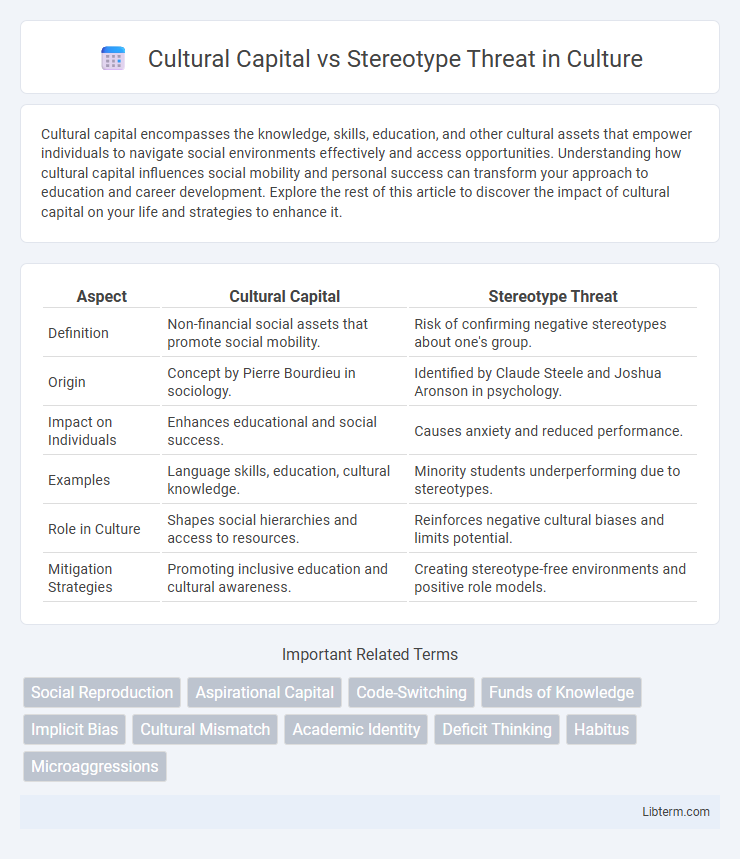Cultural capital encompasses the knowledge, skills, education, and other cultural assets that empower individuals to navigate social environments effectively and access opportunities. Understanding how cultural capital influences social mobility and personal success can transform your approach to education and career development. Explore the rest of this article to discover the impact of cultural capital on your life and strategies to enhance it.
Table of Comparison
| Aspect | Cultural Capital | Stereotype Threat |
|---|---|---|
| Definition | Non-financial social assets that promote social mobility. | Risk of confirming negative stereotypes about one's group. |
| Origin | Concept by Pierre Bourdieu in sociology. | Identified by Claude Steele and Joshua Aronson in psychology. |
| Impact on Individuals | Enhances educational and social success. | Causes anxiety and reduced performance. |
| Examples | Language skills, education, cultural knowledge. | Minority students underperforming due to stereotypes. |
| Role in Culture | Shapes social hierarchies and access to resources. | Reinforces negative cultural biases and limits potential. |
| Mitigation Strategies | Promoting inclusive education and cultural awareness. | Creating stereotype-free environments and positive role models. |
Understanding Cultural Capital: Definition and Components
Cultural capital refers to the non-financial social assets that influence an individual's social mobility, including education, intellect, style of speech, dress, and physical appearance. It comprises three main components: embodied cultural capital (long-lasting dispositions of the mind and body), objectified cultural capital (physical objects owned), and institutionalized cultural capital (educational qualifications). Understanding these elements is crucial for addressing how cultural capital interacts with stereotype threat, which can hinder the performance and participation of marginalized groups in various social and academic settings.
Stereotype Threat: Origins and Psychological Impact
Stereotype threat, originally identified by social psychologists Claude Steele and Joshua Aronson in the 1990s, occurs when individuals fear confirming negative stereotypes about their social group, leading to decreased performance in academic or professional settings. This psychological phenomenon triggers anxiety and cognitive load, impairing working memory and executive function, which ultimately hinders task execution. Research demonstrates significant impacts on marginalized groups, particularly in standardized testing and STEM fields, highlighting the importance of addressing stereotype threat to promote equity and inclusion.
Comparing Cultural Capital and Stereotype Threat
Cultural capital refers to the non-financial social assets such as education, intellect, style of speech, and appearance that promote social mobility, while stereotype threat involves the risk of confirming negative stereotypes about one's social group, which can hinder performance and self-confidence. Unlike cultural capital, which provides individuals with advantages through familiarity and access to dominant cultural norms, stereotype threat imposes psychological barriers that limit individuals' potential by inducing anxiety and self-doubt. Understanding the contrast between cultural capital's empowering effects and stereotype threat's detrimental impact is crucial for addressing educational and social disparities.
The Role of Education: Opportunities and Barriers
Education serves as a critical platform for developing cultural capital, providing students with essential skills, knowledge, and social networks that enhance academic and professional success. However, stereotype threat can create significant psychological barriers, causing anxiety and reduced performance among marginalized groups, thereby limiting their ability to fully benefit from educational opportunities. Addressing these challenges requires creating inclusive learning environments that recognize diverse cultural backgrounds and actively work to dismantle harmful stereotypes.
Cultural Capital in Diverse Learning Environments
Cultural capital in diverse learning environments enhances students' academic success by providing access to valued knowledge, skills, and behaviors that align with institutional expectations. It enables learners from varied backgrounds to navigate educational systems more effectively, fostering inclusion and equity. Developing cultural capital involves recognizing and valuing students' cultural identities while bridging gaps between home and school contexts.
Stereotype Threat and Academic Performance
Stereotype threat negatively impacts academic performance by creating anxiety and self-doubt among students who fear confirming negative stereotypes about their social group. Research shows that this psychological burden reduces working memory capacity, leading to lower test scores and decreased motivation. Interventions that affirm students' self-worth and foster positive identity can mitigate the adverse effects of stereotype threat on learning outcomes.
Social Mobility: Cultural Capital as a Bridge or Barrier
Cultural capital shapes social mobility by providing individuals with the knowledge, skills, and behaviors valued in dominant social institutions, facilitating access to resources and opportunities. Stereotype threat undermines performance by triggering anxiety about confirming negative social stereotypes, potentially limiting upward mobility despite possessing cultural capital. Understanding how cultural capital can either bridge or become a barrier under the pressure of stereotype threat is crucial for developing equitable policies that promote genuine social advancement.
Combating Stereotype Threat: Strategies and Solutions
Combating stereotype threat involves leveraging cultural capital through strategies such as fostering affirming environments that highlight diverse role models and validating students' identities and experiences. Interventions like value-affirmation exercises and growth mindset training help reduce anxiety linked to stereotypes by boosting self-efficacy and resilience. Educational institutions that integrate culturally responsive pedagogy and provide mentorship programs demonstrate significant improvements in academic performance and engagement among marginalized groups.
Interplay of Cultural Capital and Stereotype Threat in the Workplace
The interplay of cultural capital and stereotype threat in the workplace significantly impacts employee performance and inclusion. Employees possessing high cultural capital, such as educational credentials, social skills, and familiarity with organizational norms, often navigate workplace dynamics more effectively, reducing the likelihood of experiencing stereotype threat. Conversely, stereotype threat can undermine individuals with lower cultural capital by increasing anxiety and impairing performance, thereby perpetuating workplace inequalities and limiting career advancement opportunities.
Fostering Equity: Policy Implications and Future Directions
Cultural capital shapes access to educational resources and social networks, influencing student achievement, while stereotype threat undermines performance through anxiety related to negative group stereotypes. Policies fostering equity must address these disparities by integrating culturally responsive teaching, expanding resource allocation, and creating supportive environments that counteract stereotype-induced stress. Future directions involve longitudinal studies assessing policy impacts and the development of frameworks that simultaneously build cultural assets and reduce stereotype threat effects to promote inclusive academic success.
Cultural Capital Infographic

 libterm.com
libterm.com